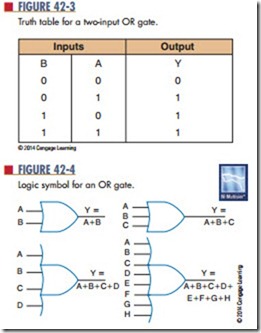Not Gate
The simplest logic circuit is the Not gate. It per- forms the function called inversion, or complementation, and is commonly referred to as an inverter.
The purpose of the inverter is to make the output state the opposite of the input state. The two states associated with logic circuits are 1 and 0. A 1 state can also be referred to as a high, to indicate that the volt- age is higher than in the 0 state. A 0 state can also be referred to as a low, to indicate that the voltage is lower than in the 1 state. If a 1, or high, is applied to the input of an inverter, a 0, or low appears on its out- put. If a 0, or low, is applied to the input, a 1, or high, appears on its output.
The operation of an inverter is summarized in Figure 42-5. The input to an inverter is labeled A and the Y output is labeled A (read “A NOT” or “NOT A”). The bar over the letter A indicates the complement of A. Because the inverter has only one input, only two input combinations are possible.
The symbol used to represent an inverter or NOT function is shown in Figure 42-6. The triangle portion of the symbol represents the circuit, and the circle, or “bubble,” represents the circuit inversion, or complementary characteristic. The choice of symbol depends on where the inverter is used. If the inverter uses a 1 as the qualifying input, the symbol in Figure 42-6A is used. If the inverter uses a 0 as the qualifying input, the symbol in Figure 42-6B is used.
Questions
1. What operation is performed by a NOT circuit?
2. Develop a truth table for the NOT circuit.
3. Draw the symbols used to represent the NOT circuit.
4. Why are two different symbols used to represent the NOT circuit?
5. What is the algebraic sum of a NOT gate?
